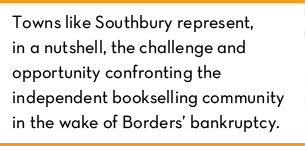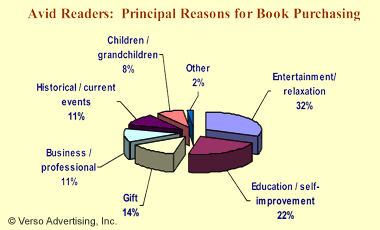By Jack McKeown and Don Linn
“Borders ended up caught between the variety of the Internet and the intimacy of the independents. Its outlets could never stock as many books as Amazon. Nor could they duplicate the native flavor of the corner bookstores…As paper books become a niche product, niche retailers will be the best place to buy and sell them.” —Edward McClelland, “How Borders Lost its Soul,” Salon.com, February 19, 2011
Southbury is a town located in western Connecticut, part of a region known as the Central Naugatuck Valley. It is a town with both rural and suburban neighborhoods, and a charming historic district. With its four-largest neighboring towns, it comprises a book market of approximately 175,000 souls whose demographics skew to relatively affluent, highly educated and older, propelled by an influx of Baby Boomer empty-nesters and retirees over the last ten years. Two weeks ago, Southbury lost it sole surviving bookstore—a 22,000 square-foot Borders in Southbury Plaza, one of the two hundred superstores closed throughout the country as a part of the chain’s bankruptcy. The nearest Barnes & Noble is in Danbury, 22 miles away. The nearest independents are in Ridgefield and Washington, 20-to-25 miles distant—too far for a casual shopping trip. Without an enterprising independent stepping in to fill this vacuum, who could blame Southbury’s population for falling into the waiting arms of Amazon as the only viable alternative?
 Towns like Southbury represent, in a nutshell, the challenge and opportunity confronting the independent bookselling community in the wake of Borders’ bankruptcy. Suddenly there will be hundreds of sustainable, niche markets with no bookstore presence—a dramatic “supply gap” of physical bookstores of a scale that has not existed for forty years. A tectonic shift of the bricks-and-mortar retail landscape is upon us, whether we are ready for it or not. Not since the explosion of the mall stores in the 1970s, the chain superstores and big-box retail in the late 1980s, and the disruptive emergence of Amazon in the late 1990s, have we seen change of this magnitude and speed. Independent bookstores are about to face a critical test in the next couple of years, and how they respond to this emerging supply gap will determine not only their long-term future, but possibly the fate of the printed book as well.
Towns like Southbury represent, in a nutshell, the challenge and opportunity confronting the independent bookselling community in the wake of Borders’ bankruptcy. Suddenly there will be hundreds of sustainable, niche markets with no bookstore presence—a dramatic “supply gap” of physical bookstores of a scale that has not existed for forty years. A tectonic shift of the bricks-and-mortar retail landscape is upon us, whether we are ready for it or not. Not since the explosion of the mall stores in the 1970s, the chain superstores and big-box retail in the late 1980s, and the disruptive emergence of Amazon in the late 1990s, have we seen change of this magnitude and speed. Independent bookstores are about to face a critical test in the next couple of years, and how they respond to this emerging supply gap will determine not only their long-term future, but possibly the fate of the printed book as well.
The digi-catastrophists predict, now that we have reached 8-10% e-book penetration, that chain bookstores and independents alike are condemned to the same oblivion. That argument ignores a central truth: the chains and independents have evolved to present nearly antithetical shopping experiences. As Edward McClelland notes above, where do you locate the competitive advantage in a 150,000-volume superstore relative to the endless storefront of the internet? Independent bookstores, on the other hand, with their focus on finely curated inventory, hand-selling, and a robust program of local events and community outreach, offer a shopping experience that dramatically differentiates them from their chain competition. The independents could be well positioned to move into niche markets abandoned by the chains, while simultaneously upping their game on the Internet with programs such as Google eBooks and the American Bookseller Association’s IndieCommerce web-hosting engine.
What will it take for independent bookstores to seize the opportunity? Continue reading

